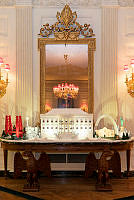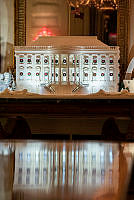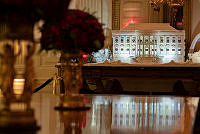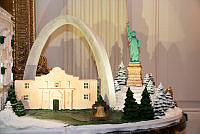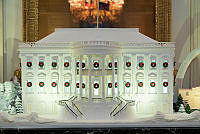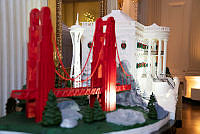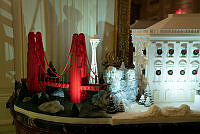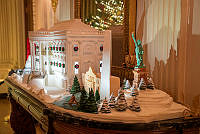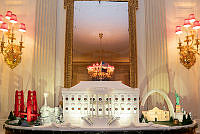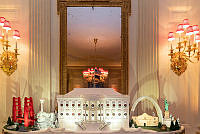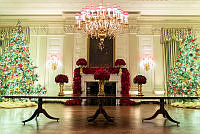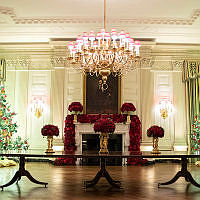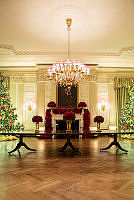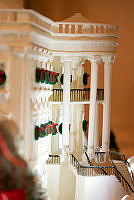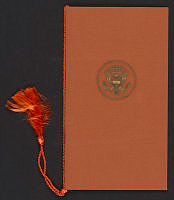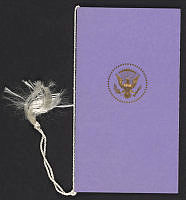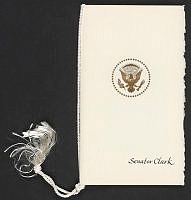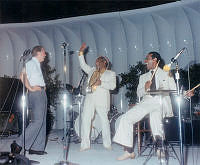The Burning of Washington
Copyright © Fall 1998 White House Historical Association. All rights reserved under international copyright conventions. No part of this article may be reproduced or utilized in any form or by any means, electronic or mechanical, including photocopying, recording, or by any information storage and retrieval system, without permission in writing from the publisher. Requests for reprint permissions should be addressed to books@whha.org
Shortly before Mordechai Booth fled the capital on Wednesday, August 24, 1814, he rode over to the President’s House to see whether anyone was still inside. Near the entrance he saw an American colonel who dismounted, walked to the front door, pulled hard on the bell rope, banged on the door, and shouted for the steward, Jean Sioussat, known as French John. But, Booth recorded, “all was as silent as a church.” Only then did this senior clerk at the Navy Yard grasp the awful reality “that the metropolis of our country was abandoned to its horrid fate.” Within hours the President’s House and the few other public buildings had been set on fire by British occupation troops. The inferno was so great that the glow in the night sky was seen from fifty miles away by British crewmen aboard warships in the Patuxent River by anxious Americans in Baltimore and in Leesburg, Virginia.
In the five years it took to research and write a book on the burning of Washington, nothing struck me as more poignant than Booth’s wrenching despair at that moment. It seemed to express the howl of a nation. Yet this was only a passing incident in a roller coaster of dramatic events. Within three weeks the British would try to bludgeon their way into Baltimore by bombarding Fort McHenry from warships, only to be turned away by a stoic defense that inspired an eyewitness, Francis Scott Key, to compose the words of “The Star Spangled Banner.” Days later the drama returned to Washington as Congress narrowly defeated a proposal to move the capital to another city to save the cost of rebuilding. Perhaps they had been influenced by the foreboding of one southern congressman who warned, “If the seat of government is once set on wheels, there is no saying where it will stop.” But this drama was itself overshadowed on Christmas Eve, when U.S. and British peace commissioners signed the Treaty of Peace and Amity in Ghent, Belgium, bringing to an end a costly war that had exhausted both nations.
News of the signing took more than a month to cross the Atlantic, arriving too late for men who would die in vain as Andrew Jackson’s makeshift army of ruffians, hillbillies, pirates, and militiamen squared off in a flat field of sugarcane stubble against seasoned British regulars of multiple European campaigns. In the finale to this extraordinary leapfrogging of epic events, Jackson’s men recorded one of the most lopsided victories in military history—even though it was a needless slaughter of foes who did not know they were already at peace.
The burning of Washington, which completely gutted the President’s House, would not have taken place but for the ongoing war between Britain and France, who tried to weaken each other by targeting trade with neutral American ships. The French felt free to seize British cargo aboard American ships and bar U.S. vessels from European ports if they had first docked in British harbors. The British blocked American vessels from entering French-controlled ports unless they first anchored in British harbors.
The British also boarded hundreds of American ships on the high seas, hauling off droves of their own sailors who had deserted to the growing American merchant fleet, which offered better pay and conditions. The swaggering imperial power used the blunt instrument of its fearsome navy, refusing to recognize the rights of its sailors to renounce citizenship and become naturalized Americans. During a six-year period through 1810 the British snatched almost 5,000 sailors off American vessels, including 1,361 native-born Americans, who were later freed with few apologies.
Goaded to mounting fury, Americans needed little coaxing to bring them to war. A British diplomat in Washington clearly saw the possibility of a clash when writing home to his mother: “While we are aiming blows at the French marine we want elbow room, and these good neutrals won’t give it to us, and therefore they get a few side pushes which make them grumble. However, I hope that they will see their interests better than to seriously quarrel with us.”
These repeated affronts to the dignity of a free and sovereign people were insufferable for proud young Americans like Henry Clay of Kentucky and John C. Calhoun of South Carolina, both of whom were born after the Declaration of Independence. The elections of 1810 sent this formidable duo and other young “war hawks” to Congress, and it quickly became evident that what was tolerable for older Americans had become untenable for the new generation. They preferred “war with all its accompanying evils to abject submission.” The wound to national pride had festered for so long that appeals to transatlantic ties made no impression. The leader of those opposed to war, Representative John Randolph of Roanoke, argued in vain against a fratricidal war against those who shared the same blood, religion, language, legal system, representative government, and even the works of Shakespeare and Newton. The war hawks carried the day in June 1812, and with his signature to the congressional approved declaration of war, President James Madison locked the snippety transatlantic upstart into battle against the mightiest power on earth.
But why would the British target Washington as the war entered its third year, after rumbles and clashes confined to the distant Canadian border? The American capital was nothing more than a gawky village, a mere embryo of the city it aspired to be. Only fourteen years had passed since the capital had moved from Philadelphia, and the population had grown to little more than 8,000, of whom one-sixth were slaves. The clammy expanses of its Potomac site were still almost barren and certainly bleak. Attorney General Richard Rush described Washington as “a meager village with a few bad houses and extensive swamps.” Augustus John Foster, who would be promoted from junior diplomat to the last British minister to the United States before the two countries went to war, lamented his posting to “an absolute sepulcher, this hole.” It was no coarse, woebegone, and lacking in refinement that in another letter home Foster wailed, “luckily for me I have been in Turkey, and quite at home in this primeval simplicity of manners.”
Even though Washington had no strategic significance for the British military, the commander and chief of the North American station, Admiral Sir Alexander Cochrane, had it in mind to give the American “a complete drubbing.” It would avenge the excesses of American who had plundered and burned public and private buildings the year before in York (modern Toronto), the capital of Upper Canada. Above all, seizing the capital would humiliate and demoralize American and, as a bonus, might even lead to the disintegration of the United States. Early warning signs that Washington would be targeted went unheeded, even though the British press had openly speculated on the fate of the American capital. Little action was taken, even after U.S. emissaries in Europe warned that the fall of Napoleon in mid-1814 would free up thousands of British troops for the war against America. Secretary of War John Armstrong refused to take these signals seriously, even as the British fleet sailed into the Patuxent River, fifty miles east of Washington, in August 1814. “By God,” he fumed at Major General John Van Ness, the uneasy chief of militia in the District of Columbia, “they would not come with such a fleet without meaning to strike somewhere. But they certainly will not come here! What the devil will they do here? No! No! Baltimore is the place, Sir. That is of so much more consequence.”
If the secretary of war, a former major general with access to every morsel of intelligence, refused to take the British seriously, small wonder that the general population was caught off guard. As word of the British advance on land filtered through to Washingtonians, the uneasy calm turned into a full-fledged flight, driven by fear, then stark terror in the widening pandemonium.
It was the hottest summer in memory and no rain had fallen for three weeks. The dusty roads were clogged with desperate refugees, their meager possessions spilling over in the stampede to escape. Others fled to the wooded surroundings, preferring the security of the wild to the insecurity of their homes. By the time the British set food on Capitol Hill after sunset on Wednesday, August 24, about 90 percent of Washington’s residents had bolted. Among those who escaped was Georgetown librarian and bookshop owner Joseph Milligan, who fled far across Virginia, arriving so incoherent and irrational at the home of an acquaintance that he told his host he thought he was being pursued by the British.
Saner counsels prevailed in the government agencies, where many of the offices remained staffed because most of the clerks were over the age of forty-five and therefore exempt from call-up into the militia. But in the basement of the House of Representatives most of the offices were empty because nearly all of the employees were young men. Only J.T. Frost, a newcomer over forty-five, remained at this desk. In this moment of acute crisis a man of scant experience and even less authority was burdened with the responsibility for making snap decisions of crucial importance. He was sorely in need of the guiding hand of the clerk of the House of Representatives, Patrick Magruder, a former member of Congress and custodian of the Library of Congress. But here, as in so many instances throughout this catastrophe, the human factor was paramount. Events turned on the nature and whereabouts of individuals. Magruder had been ill for months and had finally taken the advice of his doctor to leave the city to try to restore his health at mineral spas.
Frost’s colleague, Samuel Burch, had tried hard to persuade his superiors to let him remain at his desk in the hope of saving the House papers. But he, too, had been marched out of the city to meet the enemy. He was finally stood down at night on Sunday, August 21, three days before the British seized the capital. But when he went looking for transport the following day, it was already too late. Most of the carts and wagons had been grabbed by the military, and the remainder were piled high with the goods of civilians in flight.
In desperation, Burch ordered three messengers to scour the countryside for transport. They came back with only one cart and four oxen, procured from a man who lived six miles out in the countryside. Into this single cart they loaded the most important documents of the House of Representatives, then turned the oxen around and drove nine miles into the countryside, where they unloaded the documents in a place of safety. They returned to Washington, but on Wednesday, August 24, just hours before the British hoisted the Union Jack on Capitol Hill, they all joined in the general exodus of refugees.
Burch and Frost were frustrated beyond measure. Both men knew they could have saved all the papers of the House, and even the vast contents of the Library of Congress, if only they had been able to seize more transport.
The archival material of the Senate was in equal jeopardy because no one of administrative seniority was on hand to take charge. Samuel Otis, the secretary of the Senate since 1789, had died in April 1814, and no one had appointed his successor in the intervening four months. The principal clerk was away from the city, leaving only two younger clerks, John McDonald and Lewis Machen, to decide whether to take matters into their own hands. Machen, twenty-four, should have been called up into the D.C. militia, where he commanded a company with the rank of captain, but seven weeks earlier he had bought a farm in Maryland, which disqualified him from holding a commission in the District. He had not yet been called up into the Maryland militia, so he decided to make himself available for civilian tasks at the U.S. Capitol.
Machen waited in vain for an executive order or instructions from higher up, but neither was forthcoming. By noon on Sunday the 21st, just three days before the British marched into Washington, he could wait no longer. All around him he saw signs of “doubt, confusions and dismay.” He gave McDonald an ultimatum: help remove the Senate documents from the Capitol or he would act alone. McDonald readily agreed, but now they were faced with finding suitable transport, a commodity that had become more precious than jewelry.
Machen obtained a single wagon by telling the driver he would impound it if the driver did not hand it over voluntarily. However, when they arrived back at the Capitol, they discovered McDonald had gone, apparently to make arrangements for the safety of his family. Machen, the driver, and a messenger then loaded the most valuable documents, including what he later said was the only copy of the Senate’s quarter-century of executive history, and another that listed the names and positions of all American military forces. They set off at sunset for Machen’s farm in Prince George’s County, Maryland, but were still within the borders of the District of Columbia when the wagon lost a wheel. Fortunately, they were near a blacksmith’s shop and were able to steal a replacement. But later that night, when they were still two miles away from Machen’s farm, the wagon overturned, and repair and reloading took several hours. The following morning, when McDonald arrived, he took the loaded wagon to the Quaker village of Brookeville, in neighboring Montgomery County, out of the path of the advancing British. The Senate documents remained there until the following month, when they were returned to Washington.
Secretary of State James Monroe, out spying on horseback as the British advanced east of Washington, sent a scribbled note to the State Department telling his staff to secure as best they could the precious national documents and departmental records. One of the clerks, Stephen Pleasonton, hurried out to buy coarse, durable linen and ordered it cut and made up into book bags. Together with other clerks, he stuffed the bags with the Declaration of Independence, the Constitution, international treaties, and the correspondence of George Washington, including the historic letter resigning his commission.
As they worked in a passageway of the War Department, located a short distance from the west flank of the President’s House, Secretary of War Armstrong passed by and rebuked Pleasonton for being an alarmist in believing the British would march on Washington. Pleasonton replied without hesitation that he had a difference belief and thought it prudent to try to safeguard the papers of the Revolutionary government.
Pleasonton loaded the bags into carts and crossed the Potomac River, driving two miles upstream above Georgetown, where he deposited them in an abandoned mill. But then he had second thoughts, for the mill was opposite Foxall’s Foundry in Georgetown, the largest manufacturer of munitions in the country, and certain to be targeted by the British. A spy or turncoat could easily lead the enemy to his nearby hiding place. So he reloaded the carts with his precious cargo and drove thirty-five miles inland to Leesburg, Virginia, where he placed the documents in an empty house, locked the door, and gave the key to the local sheriff. Then he checked into a hotel, too tired to join the townspeople who flocked into the streets that night to watch the glow in the sky over the burning city of Washington.
When the advance party of British commanders rode onto Capitol Hill at sunset, they were met by a volley of sniper fire from a house at the junction of Maryland Avenue, Constitution Avenue, and Second Street, N.E. These were the only shots aimed at the invaders in the capital now quiet and almost abandoned. The shots felled the horse ridden by the top British commanded, Major General Robert Ross, and killed at least one enemy soldier and wounded another. In keeping with their policy of destroying buildings used for hostile purposes, the invaded retaliated by quickly torching the house, even though the anonymous snipers had run off. Before darkness set in, one Washingtonian looked out of her window in horror to see the Union Jack flying atop Capitol Hill as enemy troops moved about brandishing Congreve rockets.
Some of the invaders now closed in on the 67-foot-high twin buildings of the Capitol—the Senate on the north and the newer House on the south. The central part of the Capitol was not built; the two wings were linked by a covered 100-foot-long wooden walkway. Other invading troops marched south to burn more of the Navy Yard, already roaring with flames set pre-emptively by Americans hoping to deny the British supplies and naval vessels.
When the British entered the halls of the House and Senate, they passed through monumental interiors of stone adorned with fluted columns and arched entrances below domed vestibules. They raced up grand staircases into ornate rooms with vaulted ceilings. One young officer, expecting to find “republican simplicity,” was astonished by evidence all around him of “monarchical splendor.” The foreigners were so awed by the grandeur of the buildings that a number of junior officers were dismayed by the order to set it all on fire.
The architect in charge for the past decade, English-born Benjamin Henry Latrobe, had supervised with a perfectionist’s rigor as he created a national capitol that, in its formidable beauty, could compare with many of its counterparts across the sea. There were no sculptors of note in the young republic, so Latrobe had looked to the land Michelangelo and Donatello, of Leonardo and Cellini, and after he found two worthy Tuscans he hired them. Giovanni Andrei had worked too slowly for the impatient Latrobe, but when he finished the fist of his columns the architect had rejoiced at this “artist of first rate excellence.” Latrobe had commissioned from the other Tuscan, Giuseppe Franzoni, a grand American eagle, with a wingspan of more than twelve feet. When it was complete, Latrobe declared it the finest eagle in the entire history of sculpture. It hung high above the Speaker’s chair, facing the British invaders when they entered the chamber of the House of Representatives.
The colossal eagle suffered the same fate as the Capitol’s other glorious works of art when the vandals lit bonfires made from piles of furniture spread with the combustible content of the Congreve rockets. The heat was so fierce that glass oil-burning lamps and one hundred panes of English plate glass skylights melted into the sizzling debris. Sheets of flame created such heat that the outer stone of the columns expanded and fell off, leaving the deformed shafts wobbly and grotesque. The heavily timbered Library of Congress, stacked with about three thousand volumes of rare books, burned to oblivion. The 86-foot-long room had a 36-foot-high flat ceiling, which, if vaulted, might have served as a firebreak.
There was something incongruous about the devastation and havoc behind them and the quiet ahead, as one hundred British troops advanced silently in two orderly columns down Pennsylvania Avenue, between double rows of stately Lombardy poplar trees. Slaves raced ahead warning residents to escape while they could as the invaders were on their way to burn the President’s House and flanking government offices.
Along the route, just over a mile long, the British commanders stopped several times to assure anxious residents that they lives and private property would safe so long as they did no take up arms against the occupying forces. These were no glib promises made on the spur of the moment. General Ross even detailed a Scottish officer, Major Norman Pringle, to command a company specifically to protect private property along Pennsylvania Avenue. They would perform so honorably that Americans would remember them respectfully for years afterward.
As they approached the southeast junction of Fifteenth Street and Pennsylvania Avenue, the British ringed the low brick boardinghouse run for the past two months by the widow Barbara Suter. General Ross teased the frightened woman, telling her he had “come, madam, to sup with you.” She tried to divert him to the Washington Hotel across the road, but Ross would have none of it, telling her she had a superior location because of its better view of the public buildings. In their brief encounter she was horrified to learn from Ross that one of his spies had duped her a few days earlier when she had taken him for a British deserter and fed him against the advice of one of her permanent residents, the postmaster general. As he left, General Ross told her to prepare a meal for later that night when he would return with a number of officers.
Now within a few hundred yards of the President’s House, the occupation forces were approaching the from the opposite direction to that taken by a procession of dignitaries, led by Freemasons in hierarchical order, who had taken part in the ceremony in which the cornerstone had been laid twenty-two years earlier. At least one American accompanied the British soldiers and sailors into the President’s House. Roger Chew Weightman, a young bookseller, recently married, was made to accompany the invaders into the mansion where Admiral George Cockburn teased him with mischievous relish. When Cockburn told him to select a memento of the visit, Weightman chose an item of value, only to be told by the admiral that everything of value would be destroyed and the he must instead select a worthless souvenir.
The vandals were tired, thirsty, and famished. It was almost midnight and the end of an exhausting day that had begun with a seven-hour forced march from near Upper Marlboro, through miles of woods, thickets, and brush until they reached Bladensburg, where they had fought a running battle with Americans in heat so fierce that eighteen invaders dropped dead from exhaustion. And then they had marched another six miles to Washington.
Now that they were inside the President’s House they feasted inelegantly on food and wine, prepared for a table of forty military and cabinet officers expected for dinner by Dolley Madison. One of the Britons toasted the health of their Prince Regent. Another raised his glass to the success of His Majesty’s land and naval forces. Then they drank “to peace with America and down with Madison.” Someone found one of James Madison’s tricornered hats and, raising it by the tip of his bayonet, declared that if they could not capture “the little president” they would parade his hat in England.
Sailors hurried up the stairs and into the more numerous rooms above, where they snatched souvenirs and clothing. But already there were signs of looting by local thieves who had broken in earlier. Drawers were opened and their contents strewn around haphazardly. Whatever was not carried off by the British would perish in the fire.
Only two objects of art that were in the President’s House before the conflagration of August 1814 remain in the White House today. One is Gilbert Stuart’s full-length portrait of George Washington, which now hangs in the East Room. The other is a small wooden medicine chest in the downstairs Map Room. Both were taken out of the mansion in dramatic circumstances before the British burned the building.
Dolley Madison, one of the most beloved women ever to occupy the White House, had displayed a courage rare among Washington’s residents. She stayed on in the President’s house even after her guard of one hundred military men had fled. The president’s wife refused to be rushed even after a horseman galloped down Pennsylvania Avenue warning all to flee because the British army had routed American forces at Bladensburg, about six miles northeast of Washington. She insisted on staying to save the portrait of the first president, which then hung on the west wall of the large dining room. It had been acquired by the federal government as a state portrait for the President’s House in 1800 at a cost of $800.
At this calamitous moment two New Yorkers entered the room and asked if there was anything they could do to help. One of the men, a ship owner named Jacob Barker, was a close friend of the Madisons, and, like Dolley, a Quaker. His companion was Robert DePeyster.
“Save that picture if possible!” cried Dolley Madison. “Under no circumstances allow it to fall into the hands of the British!” When she saw that her slave, Paul Jennings, and another servant were taking too long to unscrew the giant frame from the wall, she told them to break the wood and take out the linen canvas. At that moment French John entered the room, and seeing the potential for irreparable damage to the painting, ordered Jennings to stop. According to traditional accounts, with Dolley’s approval he took out a penknife and cut the heavyweight English twill fabric from its frame.
French John gave the canvas to Barker, who started to roll it up until stopped by the Frenchman for fear the paint would crack. Barker and DePeyster then escorted the portrait in a wagon through Georgetown into the countryside, where they left it with a farmer they lodged with overnight. A few weeks later Barker retrieved it and gave it back to Dolley Madison.
The medicine chest, small enough to be carried off in one hand, was returned to the White House 125 years later, in 1939, by Archibald Kains, a Canadian, who wrote a cover letter to President Franklin D. Roosevelt that it was “looted or pillaged from the White House by my grandfather, who was paymaster of the Devastation, one of the boats that sailed up the Patuscent (sic) at that time. …I hope you will find an appropriate resting place for this little relic and should be very pleased if you gave it shelter in your own home.”
The most conspicuous case of the British enforcement of the rule against wanton looting involved a soldier armed with a musket who robbed residents close to the charred skeleton of the President’s House. The first victim was John Macleod, proprietor of the Washington Hotel on Pennsylvania Avenue. After threatening to set fire to the building, the robber moved to the home of a second victim as a neighbor sped to British headquarters on Capitol Hill to sound the alarm. Two British officers galloped down Pennsylvania Avenue and entered the home of a third victim as he was being robbed.
What happened next was witnessed by a Washingtonian. One of the young officers shouted, “You villain! You have turned thief and are disgracing your country!” The thief denied doing anything wrong, but he was contradicted by Macleod the hotelier. Infuriated, the officer clenched his fist and punched the soldier so hard that he staggered and his hat fell off. It was found to contain silk shawls and other valuables. When he saw this the officer whacked the thief with the butt of his pistol and threatened to shoot him on the spot unless he set off immediately for British headquarters. He was put on his stolen horse and escorted up to Capitol Hill. On the way he tried to escape but his luck had run out. He was paraded at headquarters and then shot dead. Two other British thieves caught by their own men were each given one hundred lashes.
The worst looting by Washingtonians took place while the British were still in the nation’s capital. The morning after they burned the President’s House and the Capitol the British returned to the Navy Yard to burn what had not been destroyed the night before. They came and went within fifteen minutes. Local residents then went gleefully wild in an orgy of theft at the unprotected Navy Yard. They swarmed into houses and scurried from cellars to attics snatching anything that could carried away, even ripping fixtures off the walls and tearing locks out of doors. The following morning, after the British had left, Washingtonians returned to the ruins of the Capitol and the President’s House to pick and pluck like vultures.
After a night and a day of torching nearly all of the public buildings, and even a few private businesses, including ropewalks, which sent billowing clouds of choking black smoke over the capital, the British withdrew to their ships, afraid that their path of retreat might by blocked by American troops. The occupation of Washington by British troops lasted about twenty-six hours, but evidence of their vandalism survives to this day. Some of the blocks of Virginia sandstone that make up the original walls of the White House are clearly defaced with black scorch marks. They are the indelible strains from the fires of 1814.




